Posted on 12/19/2025

On cold mornings, it is tempting to start the car, let it sit for ten or fifteen minutes, and hope that extra idling is “good” for the engine. You might have heard different advice from friends, family, and older owners who grew up with carbureted vehicles. Modern engines, however, are built very differently. Warming up the right way protects the engine and saves fuel without wasting time in the driveway. Why Cold Starts Are Tough on Modern Engines Most engine wear happens in the first moments after start-up. The oil has settled back into the pan, metal parts have cooled and shrunk slightly, and clearances are just a little larger than they are at full temperature. Until the oil pump gets lubricant to the top of the engine and across all the bearings, there is less protection between moving parts. Cold weather makes this worse by thickening the oil and making it slower to flow. That is why using the correct oil viscosity for your climate and letting the ... read more
Posted on 11/28/2025

When your car keeps drifting right, even on a fairly straight road, it wears you out and quietly wears out tires. The cause is often simple, but letting it ride leads to uneven tread, added fuel use, and suspension stress. The two most common suspects are incorrect tire pressure and wheel alignment. Here’s how to tell which issue you’re dealing with and what to do next. What “Pulling Right” Really Means on the Road True pull means the steering wheel wants to turn by itself, and you need steady input to keep the car centered. A lighter drift may only show up at certain speeds or road surfaces, which can point to tire pressure differences or road crown rather than a serious fault. If the pull stays consistent on different roads, it’s more likely a vehicle issue than the pavement. Quick Tire Pressure Check Can Correct a Drift Start with the fastest test. Use a quality gauge on all four tires when they are cold, then set p ... read more
Posted on 10/31/2025

As the first frost approaches in Colorado, it's easy to focus on your heater or windshield wipers and forget about the cooling system. But your radiator, hoses, and coolant are just as important during winter as they are in summer. In fact, a neglected cooling system is one of the most common reasons cars break down in cold weather. Getting your system ready before the temperature drops can help you avoid engine trouble, unexpected leaks, or overheating, even in freezing conditions. Check the Coolant Mixture Before the Cold Hits Coolant, also called antifreeze, keeps your engine from freezing in the winter and overheating in the summer. The standard 50/50 mixture of antifreeze and water is ideal for most climates, but the ratio needs to be correct to offer full protection during a Colorado cold snap. Too much water in the system, and it might freeze inside your radiator or engine block. Too much antifree ... read more
Posted on 9/26/2025

When your car struggles to start or the lights seem dimmer than usual, it’s natural to assume the battery is the culprit. However, alternator issues can cause similar symptoms, making it difficult to know which component is actually failing. Since both work together to power your vehicle, identifying the difference early can save you from getting stranded or paying for unnecessary repairs. How the Alternator and Battery Work Hand-in-Hand Your battery provides the initial power to start the engine, but once the engine is running, the alternator takes over. It keeps the battery charged while supplying electricity to your car’s systems, including headlights, dashboard displays, and climate control. When one of these components fails, the other often feels the strain. That’s why a weak battery can sometimes mimic alternator trouble and vice versa. Knowing the key differences between their symptoms is the best way to determine what’s wrong ... read more
Posted on 8/29/2025

Electric vehicles (EVs) are changing the way we drive. With smoother acceleration, lower emissions, and near-silent operation, EVs offer a futuristic driving experience. But while the quietness of electric cars is often seen as a benefit, it also presents a new set of challenges—especially in crowded city environments. As more electric cars hit the streets of Broomfield and beyond, both drivers and pedestrians need to be aware of the hidden dangers that come with their silence. Let's explore what makes electric cars different in traffic, and how we can all stay safer on the road. The Problem with a Quiet Ride One of the standout features of EVs is their minimal noise. Without an internal combustion engine humming under the hood, these cars glide through neighborhoods and intersections with hardly a sound. This is a huge win for noise pollution, but it also means people don’t always hear them coming. In densely populated city areas with high pedestri ... read more